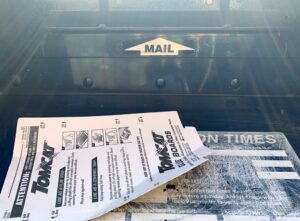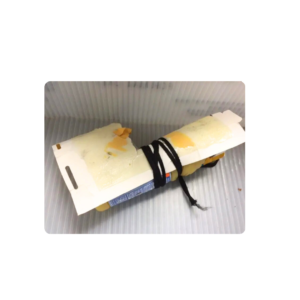Signed, Sealed, and Undelivered
Why Marine Park Mailboxes Seem to be Disappearing
Ita Yankovich
One seemingly quiet afternoon I arrived home to a message from the assistant manager of my local Apple Bank branch. It was already past closing time, and her request to call back before noon didn’t concern me. Little did I know, this simple message would unleash a whirlwind of chaos that would disrupt my life for months to come.
When I called the bank the following morning, the manager asked if I knew a “Kenneth Grant.” I didn’t. Apparently, someone with that name had withdrawn almost ten thousand dollars from my account using a fake check with my signature on it. The bank noticed the suspicious activity, but since they couldn’t reach me, they allowed the withdrawal after verifying my signature.
I keep meticulous records, so I was able to track the fraudulent check back to a recent payment I’d mailed out to Con Edison. It seems my mail was stolen, and the thief, “Kenneth Grant” (which turned out to be an alias), was able to alter the check information. The bank assured me that they would honor recent checks but advised me to close the account as a precaution. Later, it was revealed that due the sensitivity of the case, all recent checks issued were denied.
Within the next few months, I was inundated with bounced checks, late payments, penalties for non-payments, and even an IRS fine for providing them with what they deemed was a fake account number. It was also incredibly embarrassing to explain to various friends and neighbors why our gift checks (for recent simchos) were bouncing. It took months to untangle the financial chaos.
Finally, after months of investigation ruling out foul play on my part, the money was returned to my account. Everything went back to normal… until a month ago, when I came home to another message from the bank. This time, someone named “Azarya Williams” tried to withdraw $7,600 from a different account, but the bank was proactive and preempted the transaction . Once again, the stolen check was one I had mailed, and the thief had altered the information while leaving my signature untouched.
Now every time I need to mail something, I become paranoid wondering if the letter will ever reach its destination, or will I thrice become a victim of mail theft.

You’ve Got (No) Mail!
It seems like I’m not alone in experiencing mailbox issues in the neighborhood.
After the second fraud incident, I called the USPS to report evidence of tampering with the mailbox I’d used on Quentin Road and East 32nd. They informed me that I wasn’t the first caller that day; in fact, they had received two other reports already. A few weeks later, the mailbox was removed.
I had assumed that location was safe due to the high traffic and the public school’s crossing guard presence during school hours. Now that I was more conscious of securing my mail, I began investigating which mailbox was most secure. I was dismayed to come across several posts on social media mentioning the removal of numerous mailboxes in Marine Park, including those on Avenue T and East 37th, Avenue S and East 36th, and Avenue R and East 32nd. Additionally, the mailbox on Avenue V and Kimball is currently under investigation for a sticky substance in its mail slot.
When I returned to the mailbox outside PS222 to see if there were any signs of meddling that I might have overlooked when I pushed my envelopes through, I felt and saw thick, bumpy glue all around the rim of the mail slot.
What is Mail Theft?
While the world increasingly goes paperless, sensitive information for medical, governmental, or legal purposes still travels through mailboxes daily. This vulnerability makes mail theft a growing concern, with cases reported to have surged by 400% since 2019 (The Crime Report).
Federal law defines mail theft as taking mail not belonging to you from a carrier or mailbox. This includes stealing from any receptacle designated for receiving mail. Thieves sometimes steal keys from mail carriers to access the green relay boxes before delivery. Mail theft is a federal felony (18 U.S. Code § 1708) punishable by fines and up to five years in prison. It’s different from mail fraud, which involves using the mail system to deceive others, carrying a potential 20-year sentence and $250,000 fine.
Beyond missing a birthday card or late bill payment, stolen mail can have devastating consequences. Compromised personal information can lead to identity theft, plunging victims into a nightmare of bad credit and financial turmoil. Stolen information like social security numbers, account details, addresses, and phone numbers can be used to open new accounts in the victim’s name, purchase expensive items, or create fake credit cards.
“We recognized that arrests alone couldn’t solve this issue,” states Jon Del Giudice of the U.S. Postal Inspection Service (USPS). The USPS is actively addressing this threat by implementing security measures like replacing traditional keys with electronic alternatives and deploying 10,000 high-security collection boxes in high-risk areas. These new boxes appear similar to the familiar blue boxes but incorporate undisclosed security upgrades to deter theft.

Sticky Situation
Criminals have become increasingly cunning in their attempts to retrieve mail. This is particularly true since the postal office upgraded their design in 2019, replacing the wide pull-down handles with thin slits to combat “mail fishing.” In the past, criminals used glue traps tied to shoelaces to fish out mailbox contents. Another popular method is “whitewashing” where perpetrators use digital technology or special pens to manipulate or erase the ink in the “to” field of the checks so they could write in fake names and amounts.
Mail theft is not a lone sport but has become part of organized crime activity. Mail theft often involves sophisticated criminal operations to infiltrate post office distribution centers, set up fake businesses, or create fake IDs to deposit the checks. One of the reasons it is so hard to catch them is because they don’t actually deposit the checks themselves, but rather hire “walkers” to cash these checks for them.
Going Postal
According to an ABC News report, in 2022, the U.S. Postal Service reported more than 38,000 incidents of mail theft. They projected that in the first half of this year, we’re on pace to eclipse that mark, with already more than 25,000 incidents reported. In the past five years, more than 1,000 people have been arrested nationwide.
The recent rise in mail theft isn’t just happening by itself. It’s part of a bigger increase in crime, and the USPS is struggling to fight it because of federal budget cuts. Some believe the pandemic triggered this type of crime, since criminals were tempted by the abundance of government stimulus checks being mailed out. That would explain why, according to a part of the U.S. Treasury Department named the Financial Crimes Enforcement Network, the number of banks reporting check fraud almost doubled from 350,000 in 2021 to 680,000.
In January, State Comptroller Thomas DiNapoli, Brooklyn District Attorney Eric Gonzalez, and USPS arrested Gennady Galker, an identity thief who stole more than $30,000 in checks mailed out to Brooklynites from places like the Office of Unclaimed Funds and the Jewish Communal Fund. Galker’s arrest coincided with the sentencing of a former East Flatbush postal worker who was sentenced to 30 months in federal prison for stealing $4 million in blank money orders from the Rugby Post Office on Utica Avenue.
Parcel Problems
Local businesses and residents are on high alert after reports of mail tampering in the area.
“It must have been the mailbox next to us,” shared Ann Tracey, owner of Tracey Real Estate on Avenue S. Criminals “whitewashed” checks, altering payees and amounts, causing major problems for the agency. “It’s been a big mess,” she explains. They had to stop their bank from cashing any checks without confirmation. Tracey now frequents the post office more often and says that the Marine Park Civic Association is aware of the issue and will address it at an upcoming meeting.
“If anyone has recently mailed checks or vital documents from the mailbox on E 32nd & Ave R, be vigilant to confirm its receipt,” Lenny Mark posted on the You’re probably from Marine Park, Brooklyn If… Facebook page. He admits he still uses street boxes for large volumes due to convenience, despite the risk.
Many locals are shifting to digital payments or going to the post office due to concerns about delivery.
“People have lost trust,” says Lenny. However, he believes smart practices, like checking the box before use, can still make street boxes convenient for sending everyday letters. “Maybe,” he quips, “the real robbery is the cost of stamps these days!”
Sidebar: Enveloped in Crime: How the Government is Fighting Back
With mail theft on the rise, the government is taking action. The United States Postal Service (USPS), alongside the U.S. Postal Inspection Service, has launched Project Safe Delivery to address this growing concern.
Here’s what they’re doing:
Enhanced Security: 49,000 new “e-arrow keys” have been deployed, providing stronger security measures when opening mailboxes.
Mailbox Upgrades: Over 140,000 mailboxes have been replaced, potentially offering improved security features.
Local Initiative:
Additionally, Congresswomen Nicole Malliotakis (Staten Island) and Grace Meng (Queens) introduced the USPS Subpoena Authority Act last year. This seeks to empower the USPS to combat postal crime by granting them the ability to issue administrative subpoenas.
What this means:
These subpoenas would allow the USPS to gather additional information related to financial fraud associated with mail theft. This could include bank records and surveillance footage, aiding in building stronger cases against criminal organizations involved in mail theft.
Sidebar: Stamping Out Mail Theft: Stay Safe with These Tips
Here are some easy steps you can take to protect yourself from mail theft and fraud:
You must be logged in to post a comment.